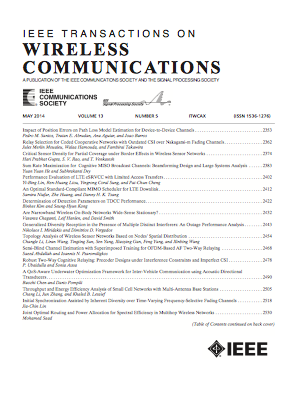卫星通信延迟-多普勒域频谱整形多址(SSMA):一个统一的多分支框架
IF 10.7
1区 计算机科学
Q1 ENGINEERING, ELECTRICAL & ELECTRONIC
引用次数: 0
摘要
具有连续探测接收机的非正交多址(NOMA),如连续干扰消除(SIC),由于其较低的复杂性,是一种潜在的卫星多用户通信技术。然而,在点波束内,信道诱导的时频偏移使多用户干扰(MUI)变得复杂,而接收机抑制MUI所依赖的路径损耗差几乎消失。为了克服上述障碍,本文利用时频偏置下时延多普勒(D-D)域的圆移特性,提出了一种D-D域频谱整形多址(SSMA)技术。通过分析D-D域频谱对信道容量的影响,我们发现通过构造非均匀的D-D域频谱,可以在接收端得到较大的用户间功率差。受此启发,提出了一种基于D-D域多分支结构的成形框架,灵活构造用户一致的功率包络。同时,引入了两种附加信号设计,以确保D-D域信息密度和星座符合所构建的功率包络。首先,通过调整各支路上信号的传输速率,以非均匀模式优化信息密度。其次,通过引入分支相位旋转并采用迭代变分逼近方法重构复合星座形状;此外,我们还设计了一个基于分支捆绑的连续检测接收机,使用乘法器的交替方向方法。该接收机可以灵活地组合可检测的分支信号,同时保持接近传统SIC接收机的复杂性。分析和仿真结果表明,与典型的D-D域NOMA相比,所提出的D-D域SSMA具有更高的可实现速率,并且可以提供$1\sim $ 4.5$ dB的误码率性能增益。本文章由计算机程序翻译,如有差异,请以英文原文为准。
Delay-Doppler Domain Spectral Shaping Multiple Access (SSMA) for Satellite Communications: A Unified Multi-Branch Framework
Non-orthogonal multiple access (NOMA) with successive detection receivers, e.g., successive interference cancellation (SIC), is a potential technology for satellite multi-user communication due to its lower complexity. However, within a spot beam, multi-user interference (MUI) is complicated by channel-induced time-frequency offset, while the path loss differences that the receiver relies on for MUI suppression almost disappear. To overcome the above obstacle, this paper exploits the delay-Doppler (D-D) domain circular shifting property under time-frequency offsets and proposes a D-D domain spectral shaping multiple access (SSMA) technique. By analyzing the influence of D-D domain spectrum on channel capacity, we identify that an enlarged inter-user power gap can be derived at the receiver by constructing a non-uniform D-D domain spectrum. Inspired by this, a D-D domain multi-branch structure-based shaping framework is proposed to flexibly construct the user-consistent power envelope. Meanwhile, two additional signal designs are introduced to ensure that the D-D domain information density and constellation fit to the constructed power envelope. First, by adjusting the transmission rate of the signal on each branch, we optimize the information density with a non-uniform pattern. Second, by introducing a branch-wise phase rotation and deploying an iterative variational approximation method, the shape of the composite constellation is reconstructed. In addition, we also design a branch-bundling-based successive detection receiver using an alternating direction method of multipliers. This receiver can flexibly combine detectable branch signals while maintaining the complexity close to the traditional SIC receiver. Analysis and simulation results reveal that the proposed D-D domain SSMA has a higher achievable rate and can provide $1\sim 4.5$ dB bit error rate performance gain compared to the typical D-D domain NOMA.
求助全文
通过发布文献求助,成功后即可免费获取论文全文。
去求助
来源期刊
CiteScore
18.60
自引率
10.60%
发文量
708
审稿时长
5.6 months
期刊介绍:
The IEEE Transactions on Wireless Communications is a prestigious publication that showcases cutting-edge advancements in wireless communications. It welcomes both theoretical and practical contributions in various areas. The scope of the Transactions encompasses a wide range of topics, including modulation and coding, detection and estimation, propagation and channel characterization, and diversity techniques. The journal also emphasizes the physical and link layer communication aspects of network architectures and protocols.
The journal is open to papers on specific topics or non-traditional topics related to specific application areas. This includes simulation tools and methodologies, orthogonal frequency division multiplexing, MIMO systems, and wireless over optical technologies.
Overall, the IEEE Transactions on Wireless Communications serves as a platform for high-quality manuscripts that push the boundaries of wireless communications and contribute to advancements in the field.

 求助内容:
求助内容: 应助结果提醒方式:
应助结果提醒方式:


